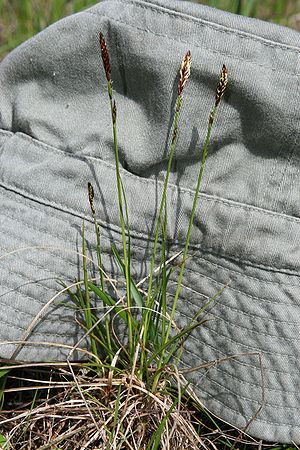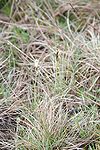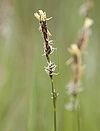Difference between revisions of "Carex inops"
(→Photo Gallery) |
(→Photo Gallery) |
||
| Line 76: | Line 76: | ||
| − | [[File: |100px]] | + | [[File: CAIN_RodGilbert_flw_good.jpg|100px]] |
| − | [[File: |100px]] | + | [[File: CAIN_SpencerAlexander_veg_SL_2012_(1).jpg|100px]] |
===References=== | ===References=== | ||
Revision as of 11:41, 23 April 2012
Contents
Taxonomy
Kingdom: Plantae
Subkingdom (unranked): Tracheobionta
Superdivision (unranked): Spermatophyta
Division: Magnoliophyta
Class: Liliopsida
Subclass (unranked): Commelinidae
Order: Cyperales
Family: Cyperaceae
Genus: Carex L.
Species: C. inops L.H. Bailey
Description
Long-stolon sedge is a loosely caespitose, perennial graminoid. It is low to medium statured compared to other Carex. Culms are 4 to 20 inches (10-50 cm) long. Leaves are slender, stiff, and wiry. Old, dead leaves are persistent, often forming fibrous tufts at the stem base. Inflorescences are terminal staminate and pistillate spikes. Male spikes may be pediceled above female spikes. The fruit is a hairy achene ranging from 1.6 to 2.5 mm long. Seedheads bear 5 to 15 fruits each.
Bloom Period
Distribution
Found in the northwestern Great Plains of the United States and Canada, ranging from the western Dakotas to Montana and Saskatchewan.
Habitat
Stands are found on gently rolling uplands with little to moderate slope.
Uses
Wildlife: Rodents, lagomorphs, and ungulates graze sun sedge. On the Pawnee National Grassland, Ord's kangaroo rats, northern grasshopper mice, thirteen-lined ground squirrels, and deer mice utilization of sun sedge ranged from 0.1% to 5.0% across 1 year. Seasonal utilization was not given. Sun sedge was an important component of the spring and early summer diets of black-tailed jackrabbits on the Pawnee National Grassland. In Wind Cave National Park, elk use of sun sedge was similar from winter to summer (3.7-5.0%) and least in fall (0.9%). Sun sedge was a minor component of the pronghorn diet on the Pawnee National Grassland. Use peaked at 4% in April and May, with only trace amounts consumed in other months. Sun sedge was also a minor component in the pronghorn diet (17% frequency but 1%-4% utilization) in a needle-and-thread grass-western wheatgrass community in southeastern Alberta. On the Pawnee National Grasslands, bison grazed sun sedge in trace amounts in December and did not utilize it in other months.
First Nations: Used by Navajo as a gastrointestinal aid and to help fight infections.
Propagation
a) SEED PROPAGATION
Photo Gallery
References
Seed
Abbraviation: CAIN
Seed sample from: 2010
Average measurement: 3.6 x1.6 x 1.3
Measurement Range: L: 2.5 – 4.5, W: 1.2 – 2, D: 1 – 1.9
Features
Shape: Seeds narrow at hilum and opposite apex, rounded in middle. Opposite apex usually sharply pointed. Seed sometimes has bits of husk still attached. Hilum circular.
Color: Tan with some darker brown or black spotting. Hilum usually brown.
Surface: Some concave patches, entire seed covered in fine hair, and matte.






